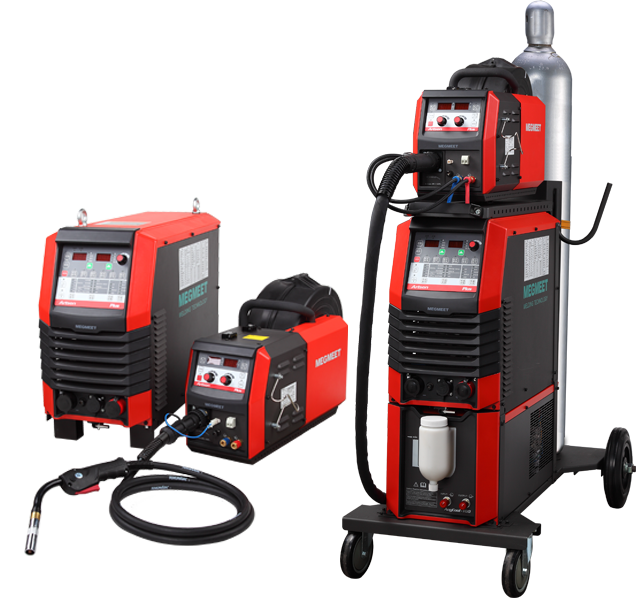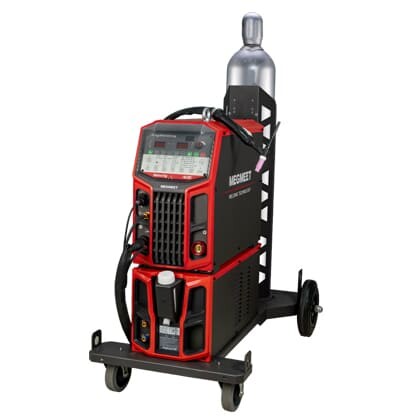Choosing the appropriate welding technique among MIG/MAG, MMA, and TIG welding is pivotal in ensuring the quality and durability of the weld. Each method possesses its unique strengths and applications, catering to diverse welding needs across industries. At Megmeet Welding, we understand the significance of precision and efficiency in welding processes. Let's delve deeper into each technique to discern the best scenarios for their application.
I. MIG/MAG Welding: Versatility and Speed
MIG (Metal Inert Gas) and MAG (Metal Active Gas) welding are similar processes that utilize a continuous wire electrode, an inert or active shielding gas, and a welding gun. These techniques excel in versatility and speed, making them ideal for various materials, including stainless steel, aluminum, and mild steel. The process's continuous wire feed allows for the efficient welding of thin materials, offering high productivity in industrial settings.

When to Use MIG/MAG Welding:
Automotive Industry: MIG/MAG welding finds extensive use in automobile manufacturing due to its speed and adaptability for diverse metals.
Sheet Metal Fabrication: Its capability to handle thin materials makes it ideal for fabricating sheet metal components with precision. Learn Tips for Setting MIG Welding Parameters for Thin Materials.
Structural Welding: Applications involving structural welding benefit from MIG/MAG's efficiency in joining different metals.
Learn How to MIG weld different metal thicknesses.
II. MMA (Manual Metal Arc) Welding: Reliability in Versatility
MMA welding, commonly known as stick welding, remains a popular choice for its simplicity, cost-effectiveness, and adaptability to various environments. This technique involves using a consumable electrode coated in flux, which generates a shielding gas upon combustion. MMA welding's portability and reliability make it suitable for diverse conditions and metal types.

When to Use MMA Welding:
Construction Sites: Its portability and capability to weld various metals make it a preferred choice in construction projects.
Maintenance and Repair: MMA welding's adaptability suits repair and maintenance tasks across industries due to its versatility in handling different metal thicknesses.
Outdoor Welding: Its ability to function in adverse conditions makes it ideal for outdoor applications.
To know the 10 MMA Welding Processes Flaws And Megmeet’s Solutions.
III. TIG (Tungsten Inert Gas) Welding: Precision and Quality
TIG welding stands out for its exceptional precision, producing high-quality welds with minimal spatter. It involves a non-consumable tungsten electrode, a separate filler material, and an inert gas shield. TIG welding's ability to create clean, intricate welds makes it suitable for specialized applications demanding precision and aesthetic quality.

When to Use TIG Welding:
Aerospace and Nuclear Industries: Applications that require impeccable weld quality and strength benefit from TIG welding's precision.
Artistic Fabrication: Artists and craftsmen prefer TIG welding for its ability to create intricate and visually appealing welds.
Critical Weld Joints: Its ability to weld exotic metals and create high-quality joints is ideal for critical weld points.
To learn Welding Tips: 6 Secrets of Beautiful TIG Welding.
IV. Choosing the Right Technique: Considerations and Conclusion
Selecting the appropriate welding technique depends on various factors such as material type, thickness, project requirements, and desired weld quality. While MIG/MAG excels in speed and versatility, MMA offers reliability in diverse conditions, and TIG welding ensures precision and quality.
At Megmeet Welding, we acknowledge the significance of choosing the right welding technique for optimal results. Our expertise lies in understanding your project's unique needs and employing the most suitable welding method to ensure superior quality and durability.
In conclusion, each welding technique—MIG/MAG, MMA, and TIG—holds its distinct advantages, catering to different applications across industries. Understanding their strengths and when to apply them is crucial in achieving impeccable welds and meeting project specifications.
FAQs on Welding Techniques
Q1: Which welding technique is best for thin materials?
A1: MIG/MAG welding excels in welding thin materials due to its continuous wire feed.
Q2: In what industries is TIG welding predominantly used?
A2: TIG welding finds extensive use in industries such as aerospace, nuclear, and artistic fabrication.
Q3: Is MMA welding suitable for outdoor welding tasks?
A3: Yes, MMA welding's adaptability makes it an excellent choice for outdoor applications.
Q4: Can MIG/MAG welding be used for structural welding?
A4: Yes, MIG/MAG welding's efficiency makes it suitable for structural welding applications.
Q5: What factors should be considered when choosing a welding technique?
A5: Material type, project requirements, thickness, and desired weld quality are essential factors to consider.






